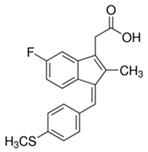Table 1.
Peripheral nerve studies that have explored the regenerative or functional recovery effects of drugs and small molecules that target PPAR-γ.
| Compound | Chemical Structure | Model | Effect on Nerve Regeneration | Reference |
|---|---|---|---|---|
| Ibuprofen |

|
In vivo: Interpositional graft on adult rat tibial nerve; treated through osmotic pumps. In vitro: NG108-15, DRG and 3D co-culture. In vivo: Transection with primary repair in sciatic nerve treated through osmotic pump. In vivo: Transection with primary repair or crush injury in sciatic nerve treated through biomaterials. |
Recovery of TFI and increase of area of axon and myelin. In vitro: Elongation of neurites In vivo: Increase in axon number. Increase in axon number and functional recovery. |
[61,62,63] |
| Diclofenac |

|
In vivo: Sciatic nerve transection with artery graft filled with diclofenac. |
Improved functional recovery and faster recovery of regenerated axons. | [64] |
| Sulindac sulfide |

|
In vivo: Transection with primary repair or crush injury in sciatic nerve treated through biomaterials. |
Improved functional recovery. | [63] |
| Pioglitazone |

|
In vivo: Crush injury on sciatic nerve in CD36-deficient mice. In vivo: Bilateral cavernosal nerve crush injury. |
Improved re-myelination. Protective effect on pelvic ganglion neurons. |
[65,66] |
| Rosiglitazone |

|
In vitro: N2A cell culture. | Promoted neurite outgrowth and increased population of neurite-bearing cells. | [67] |
This includes approved drugs as well as small molecules in experimental stages. Inclusion criteria selected literature that had studied PPAR-γ as a target to block or activate the Rho/ROCK pathway and no other signaling pathways. Drugs or small molecules targeting CNS, optic nerve, neuropathic pain, inflammation, or neurodegenerative diseases were also excluded. Relevant articles were identified and obtained from PubMed up until 4 August 2021.
